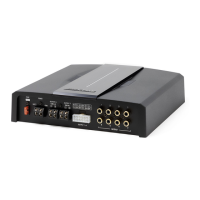19-EN
Refer to “Output type custom page” (page 14).
1 Default is Fixed [ ], There is no RTA data.
2 Click one channel Unfixed [ ], begin to
display RTA data.
3 10 bands of EQ adjustable to make the RTA
data is flat.
Refer to “EQ Adjustment” (page 16).
Refer to “Equalizer Settings” (page 16).
Hold down the mouse and push the fader left and
right to adjust the signal gain.
There are high, medium and low options. The higher
the sensitivity, the more sensitive the frequency
spectrum jumps.
AutoEQ
The PC and amp will connect automatically.
Before measurement, the application will help you
set an ideal volume.
Neutralize tone controls and processes
Important:
Be sure at this point to neutralize any tone controls
and turn off any sound processes which are
downstream from the amp.
Volume adjustment process
Upon connecting to a new amp, AutoEQ will prompt
you to start adjusting the volume level.
Important:
Make sure the microphone is connected to the amp.
Hold the microphone in the center of the cabin
about one foot from the center console.
Click the button to proceed when you are ready.
You will hear the frequency sweep (“whoop-
whoop”) playing at a low volume.
Use the volume slider on the screen to gradually
raise the volume until the input level rises to the
middle of the volume monitor.
AutoEQ will automatically stop playing the signal
after it detects a good level for a few seconds.
With level adjustment complete, the app will
prompt you to proceed to the next step:
measurement.
Figure 2 - The volume adjustment screen showing
the starting volume for the volume adjustment
process.
Figure 3 - The volume adjustment screen showing
the end result of volume adjustment.
The slider has been raised and the detected volume
is optimal.
H.level input channel type
Fixed the RTA data
EQ Adjustment
Equalizer settings
Signal gain
Sensitivity
Volume Adjustment

